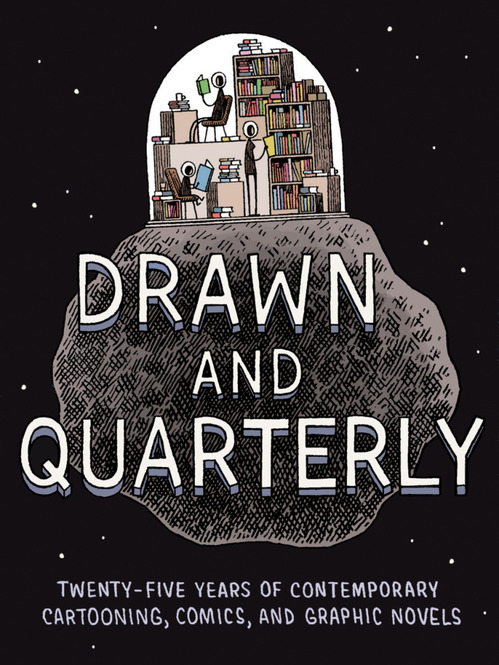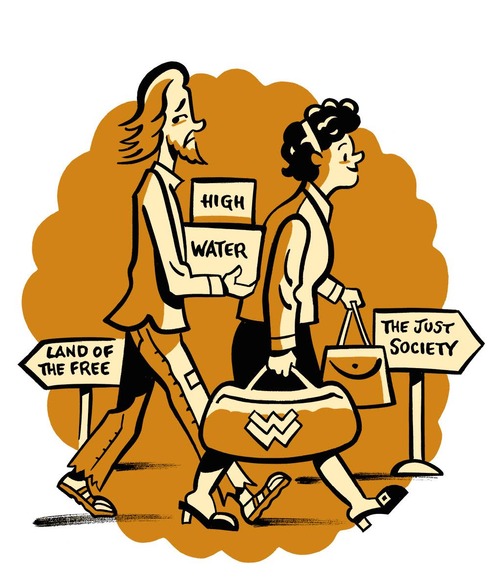Peggy Burns & Tom Devlin Discuss the Past and Future of Drawn & Quarterly
Main and Lead Illustrations by Vanessa Davis![]()
Alongside (and inside) the publishing of Drawn and Quarterly: Twenty-Five Years of Contemporary Cartooning, Comics, and Graphic Novels—a near-800-page bug squisher of a book that recaps the past quarter-century at a tiny Canadian comics publisher that became an industry cornerstone—D+Q also announced some changes in administration. Founder Chris Oliveros stepped down as publisher to pursue making comics, Peggy Burns took his place and Tom Devlin, creative director and Peggy’s husband, became executive editor. Burns and Devlin weren’t exactly new to the company. The book alone is peppered with photos and stories of and about the two of them, and their input is all over its catalog. We sent the pair the same set of questions, and although we don’t know if they conferred before answering them, they seem on the same page about D+Q’s future.
Paste: Can you both give me a brief overview of your D+Q careers, in your own words?
Peggy Burns: Chris [Oliveros] hired me in 2003 to be his publicity director. From the get-go, it was much more than publicity, which made me very happy. In university in NYC, I worked for two small businesses: a PR firm and the fashion designer Daryl K. While working for a corporate company like DC Comics is cushy, working for a small company is invigorating. At DC, there was always a certain sense that the company was bigger than any publicity it could generate. Did Kevin Smith’s Green Arrow sell because I got it good press or would it have sold anyway? At D+Q, all good deeds (and bad) are immediately felt, for better or for worse.
Tom Devlin: I started after Peggy even though we had moved to Montreal together. I was working from home freelancing but would come into the office to help her and Chris out sometimes when I was bored. Eventually this turned into a full-time production job, and then an editorship when I suggested publishing Moomin. The transition was all very organic and like Peggy has stated, in a small company you just do everything anyways, there are no real separate jobs. You just do what needs to be done.

Tom & Peggy brave the uncompromising, frigid weather of Quebec
Paste: What kinds of comics did you read when you were growing up?
Burns: Newspaper strips and Archie as a kid. I loved Brenda Starr, Blondie (Tom and I named our son Dagwood), Peanuts and Calvin and Hobbes.
Devlin: I read whatever was available. So initially that meant what was in the newspaper—Peanuts, B.C., Broom-Hilda, Pogo, Doonesbury. Later I got Archie collections from the school book club. Grocery store three-packs with Bugs Bunny and Porky Pig comics from Gold Key or Whitman. Once I had an allowance, I would get my mother to take me one town over to buy superhero comics like Amazing Spider-Man or Micronauts or Daredevil. Then I quit reading comics until I discovered Love and Rockets with issue #8.
Paste: How do you think the comics field has changed over the past 25 years? And what impact has D+Q had on that?
Burns: We are definitely in the midst of a graphic novel golden age that started about 15 years ago when it wasn’t one graphic novel like Maus making headlines, it’s several graphic novels making many headlines a year, and now it’s just routine for really, really good graphic novels to come out all year long. D+Q definitely placed an emphasis on both being literary and publishing graphic novels and being the one of the first companies to solely focus on books.
Devlin: There’s definitely a place for the kind of comics Chris envisioned 25 years ago. At that time, people like Seth, Julie [Doucet] and Chester [Brown] were making comics in spite of what audiences wanted. Now there is an audience for their work. I think our dedication to making long-form serious literary comics has helped change how people view comics and what they expect to get out of them.

Drawn and Quarterly: Twenty-Five Years
Paste: You’re particularly known for beautifully printed comics with a focus on good book design, which means printing nerds like me are attracted to your books as objects. Can you talk about some favorite projects from that perspective? Do you ever have to talk designers/comics artists into something more cost-effective? Do you have dream projects as far as printing and design?
Burns: We do make sure all of our design choices are cost effective. We don’t want to design ourselves into debt because of a die cut. And neither do our authors, so most authors are fine when you say, “if we do this or this, it brings the unit cost down.” My favorite design is the simplest of designs that lets the comics shine through.
